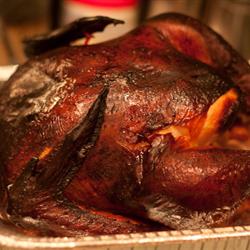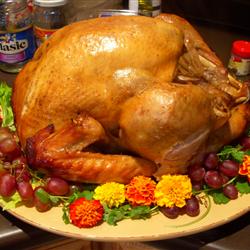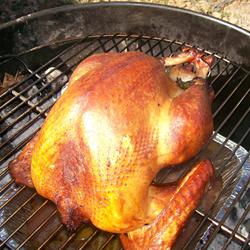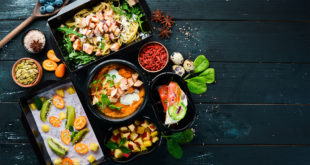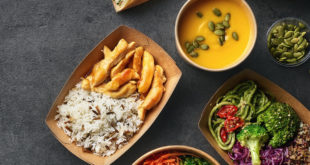In 1621, Pilgrims dressed in black and white with buckled shoes and hats atop their heads in the Plymouth Colony to celebrate their first harvest. They invited the Wampanoag Indians and everyone gobbled down turkey, stuffing, sweet potatoes and pumpkin pie.
That’s the story you probably learned as a young child. Well, it turns out that only part of that is true. Historians say there was indeed a feast that year shared by the colonists and Indians but nobody actually knows whether Turkey was really on the menu. Deer was served in 1621 and turkey may have been there too but there is no record of it. Pumpkin was available but probably not whipped into pie, sweat potatoes were not a familiar food to the colonists and cranberries may have been at the table but most likely not as a sauce or relish. Pilgrims didn’t even dress in black and white with buckled shoes and top hats.
It is still unclear why Americans started eating turkey in the 1800s for Thanksgiving but I do know one thing… It sure is tasty! That’s why I have compiled 6 different ways to cook a Turkey for your feast this year. Whether you’re serving patrons or your family, these cooking methods will work for you. Perhaps you will decide to try something new this Thanksgiving!
Deep Fried Turkey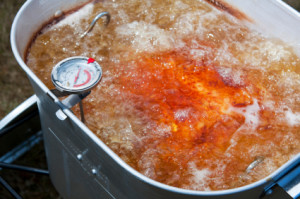
Ingredients:
- 3 gallons of peanut oil for frying, or as needed
- 1 (12 pound) turkey, neck and giblets removed
- ¼ cup Creole seasoning
- 1 white onion
Directions:
In a large stock pot or turkey fryer, heat oil to 400 degrees F (200 degrees C). Be sure to leave room for the turkey, or the oil will spill over. Layer a large platter with food-safe paper bags.
Rinse turkey, and thoroughly pat dry with paper towels. Rub Creole seasoning over turkey inside and out. Make sure the hole at the neck is open at least 2 inches so the oil can flow freely through the bird.
Place the whole onion and turkey in drain basket. The turkey should be placed in basket neck end first. Slowly lower basket into hot oil to completely cover turkey. Maintain the temperature of the oil at 350 degrees F (175 degrees C), and cook turkey for 3 1/2 minutes per pound, about 45 minutes.
Carefully remove basket from oil, and drain turkey. Insert a meat thermometer into the thickest part of the thigh; the internal temperature must be 180 degrees F (80 degrees C). Finish draining turkey on the prepared platter.
Recipe courtesy of allrecipes.com
Ingredients:
- 1 (12 pound) turkey, neck and giblets removed
- 1 (20 pound) bag high quality charcoal briquettes
- Hickory chips or chunks
Directions:
Place the charcoal into the bottom pan of the smoker. Light the coals and wait for the temperature of the smoker to come to 240 degrees F (115 degrees C). Lightly oil grate.
Rinse turkey under cold water, and pat dry. Place hickory chips into a pan with water to cover.
Place turkey onto the prepared grate. Add 2 handfuls damp chips at start of cooking, then a handful every couple of hours during the cooking process. Leave the lid on – DO NOT keep looking at turkey or you will let the heat out! Continue smoking until the internal temperature of the turkey reaches 180 degrees F (82 degrees C), or keep going until the coals die out.
Recipe courtesy of allrecipes.com
Roasted Turkey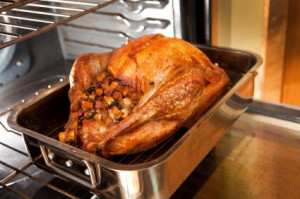
Ingredients:
- 1 (18 pound) turkey
- ½ cup unsalted butter, softened
- Salt and freshly ground black pepper to taste
- 1 ½ qt turkey stock
- 8 cups prepared stuffing
Directions:
Preheat oven to 325 degrees F (165 degrees C). Place rack in the lowest position of the oven.
Remove the turkey neck and giblets, rinse the turkey, and pat dry with paper towels. Place the turkey, breast side up, on a rack in the roasting pan. Loosely fill the body cavity with stuffing. Rub the skin with the softened butter, and season with salt and pepper. Position an aluminum foil tent over the turkey.
Place turkey in the oven, and pour 2 cups turkey stock into the bottom of the roasting pan. Baste all over every 30 minutes with the juices on the bottom of the pan. Whenever the drippings evaporate, add stock to moisten them, about 1 to 2 cups at a time. Remove aluminum foil after 2 1/2 hours. Roast until a meat thermometer inserted in the meaty part of the thigh reads 180 degrees F (80 degrees C), about 4 hours.
Transfer the turkey to a large serving platter, and let it stand for at least 20 to 30 minutes before carving.
Recipe courtesy of allrecipes.com
Ingredients:
- 1 (10-18 pound) turkey
- 1 gallon vegetable broth
- 1 cup sea salt
- 1 tbsp crushed dried rosemary
- 1 tbsp dried sage
- 1 tbsp dried thyme
- 1 tbsp dried savory
- 1 gallon ice water
Directions:
In a large stock pot, combine the vegetable broth, sea salt, rosemary, sage, thyme, and savory. Bring to a boil, stirring frequently to be sure salt is dissolved. Remove from heat, and let cool to room temperature.
When the broth mixture is cool, pour it into a clean 5 gallon bucket. Stir in the ice water.
Wash and dry your turkey. Make sure you have removed the innards. Place the turkey, breast down, into the brine. Make sure that the cavity gets filled. Place the bucket in the refrigerator overnight.
Remove the turkey carefully draining off the excess brine and pat dry. Discard excess brine.
Cook the turkey as desired reserving the drippings for gravy. Keep in mind that brined turkeys cook 20 to 30 minutes faster so watch the temperature gauge.
Recipe courtesy of allrecipes.com
Rotisserie Turkey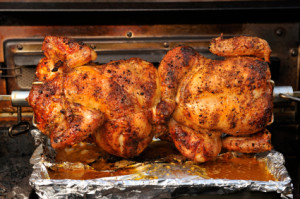
Ingredients:
- 1 (12 pound) turkey
Seasoning:
- 1/4 cup lemon pepper
- 2 tbsp fresh parsley chopped
- 1 tbsp celery salt
- 2 cloves garlic, minced
- 2 tsp black pepper
- 1 tsp sage
Turkey Stuffing:
- 1 medium onion cut into 8 equal parts
- 1 carrot cut into thin disks
- 1 apple cored and cut into 8 thick slices
Directions:
Mix together seasonings and rub over the surface and inside of cleaned and dry turkey. This is best done the night before to let the seasoning permeate the meat.
Stuff turkey and place securely on rotisserie skewer. Test it to make sure it’s well balanced and tightly secured. Make sure that the wings and legs are firmly tied to the turkey and that the turkey is well balanced on the rotisserie skewer. Prepare grill by removing grate and placing a drip pan in the center. Pan should be big enough to hold the turkey itself.
Light grill and let it heat up. If using a charcoal grill make a medium fire around the drip pan. With gas turn the burners to medium. But generally follow the manufacturer’s instructions. Half fill the drip pan with water and place the turkey on rotisserie. The cooking times should be similar to that of a 350 degree F. oven so use the time chart on the turkey packaging as a guide. You will need to use a meat thermometer to be sure of doneness.
Remove rotisserie turkey from grill when the internal temperature reaches 185 degrees F. The water in the drip pan is there to keep the drippings from evaporating away. If the pan goes dry add more water. I suggest hickory, oak or alder wood chips if you wish to add an extra smoky flavor.
Recipe courtesy of about.com
Ingredients:
- 1 (12 pound) turkey
- 1 tbsp vegetable oil
- 1 tsp Italian seasoning
- Salt & pepper to taste
Directions:
Prepare an outdoor grill for indirect medium-high heat.
Rinse turkey and pat dry. Turn wings back to hold neck skin in place. Return legs to tucked position.
Brush turkey with oil. Season inside and out with Italian seasonings, salt, and pepper.
Place turkey, breast side up, on a metal grate inside a large roasting pan. Arrange pan on the prepared grill. Grill 2 to 3 hours, to an internal thigh temperature of 180 degrees F (85 degrees C). Remove turkey from grill and let stand 15 minutes before carving.
Recipe courtesy of allrecipes.com
These are all great and tasty ways to prepare your Thanksgiving bird. And though the colonists possibly left the Turkey out of their first holiday feast it would be a shame if your guests were deprived of their Thanksgiving gobbler.
 Corner Booth Blog | TundraFMP Restaurant Supply, News & Equipment Blog
Corner Booth Blog | TundraFMP Restaurant Supply, News & Equipment Blog
